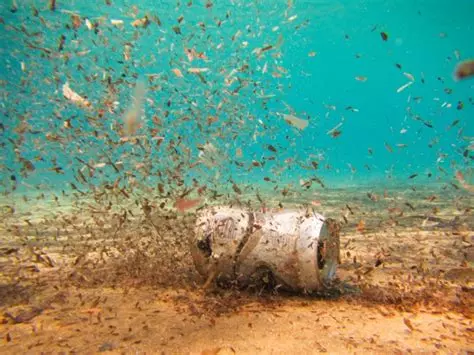Research projects: Pollution of aquatic ecosystems
Effect of plastic pollution (mainly microplastics) on aquatic ecosystems.
This is a worldwide pollution problem in the earth and a serious concern for both ecosystem and human health. The number of studies targeting plastic pollution in ocean (all ecosystems in general) is increasing. Because small size fraction of plastic debris called micro-plastics is very abundant in aquatic ecosystems; can be ingested by zooplankton and then transferred to higher trophic levels, Sami Souissi and his collaborators are actively engaged in this research topic. The studies are interdisciplinary and aiming to better understand the interaction between micro- and nano-plastics and zooplankton and the quantification of their impacts. The projects are carried out in the laboratory as well as in the field. See here our latest paper in Frontier in Environmental Chemistry (Thery et al., 2022).
Among the key and pionneer results were published in collaboration with Prof. Jae-Seong Lee (see his ResearchGate profile here) a fellow of the Korean Academy of Science and Technology and Professor at Sungkyunkwan University ranked in the top 100 universities in the world. Particularly the paper Jeong et al. (2016) is highly cited (~600 times) because it was the first demonstration of the mechanisms of toxicity when small sized plastics are ingested by zooplankton.
Recently, Sami Souissi was involved in an innovative project funded by the Interdisciplinary Mission of the French CNRS targetting ‘Plastics and micro-plastics in aquatic ecosystems’ among the only 6 awarded proposals, the project TOXIPLANKTON (see the first one on the list here) allowed to observe for the first time the interaction between high number of copepods and microplastics in turbulent conditions. For this project a high volume of copepod production was used to produce 0.5 million individuals and transfer them in the unique facility in France situated in the IMFT Toulouse to observe the swimming behaviour of copepods in realistic turbulent conditions.
The research projects target the creation of an eco-friendly approach for biobased and biodegradable materials including new biopolymers. These recent projects are based on a collaboration with Prof Jean-Marie Raquez director of the Laboratory of Polymeric and Composite Materials in the University of Mons in Belgium as well as Prof Philippe Zinck from the Laboratory UCCS in Lille specialised on Catalysis and Chemistry of the Solid.

Microplastics can be composed of different polymers (materials) and can have different life histories (i.e., degradation time, colonisation by micro-organisms, adsorption of pollutants, agglomeration with other organic material, etc.). In order to not focuss only on the problems already existing and accumulated over several decades, which remain important, Sami Souissi in collaboration with his colleagues specialists of bio-polymers and their chemistry is studying the safety of the alternative biodegradable materials in terms of possible toxicity at lower trophic levels. It is important to help industry of all plastic material to integrate a new eco-friendly label based on serious and robust scientific evaluation. In fact, the rapid degradation of a plastic bag or a bottle in the ocean means its transformation on very small particles that are ingested by zooplankton.
Several toxicity tests carried out in the laboratory are based on the study of a single contaminant effect and often by using very limited number of biological models. However, the extrapolation of these studies to real risk assessment in fiueld conditions is often limited. There is a need to increase the number of biological models and have a global view of ecotoxicology. Thanks to his interdisciplinary background in ecological studies, including modelling, Sami Souissi is a well recognised expert in the field of Ecotoxicology and have significant contributions. Below some examples of these contributions and projects:
Effects of single and cocktails of trace metals (i.e., Cadmium, Copper, Nickel, Lead, Mercury, Arsenic etc) on the lower trophic levels using microalgae and copepods as biological models.
Effect of resuspension of sediment (mainly contaminated one) on the development and fitness of sentinel species.
Effects of Persistant Organic Pollutants (POP) on aquatic environment and organisms.
The use of aquaculture of copepods allowed to produce high number of stdandized individuals that are used in different studies and allowed to obtain several scientific results published in the top ranking journals of the field.
The photo below shows part of the research facilities provided by the local authorities (the Aglomeration Community of the Boulonnais – CAB) in a spin off incubator called Haliocap situated in the city of Boulogne sur Mer, to perform the applied research and technology transfer. With such facility it was possible to use simultaneously large microcosms (beakers of 10 L) and high number of copepods to initiate several exposure experiments mimicking real conditions.

Photo of an experimental design using high number of microcosms composed by large beakers (10L) to test the effects of heavy metals, sediment coming from dredging operation in large harbors etc on copepods. The sentinel species Eurytemora affinis was used in this experiment.
